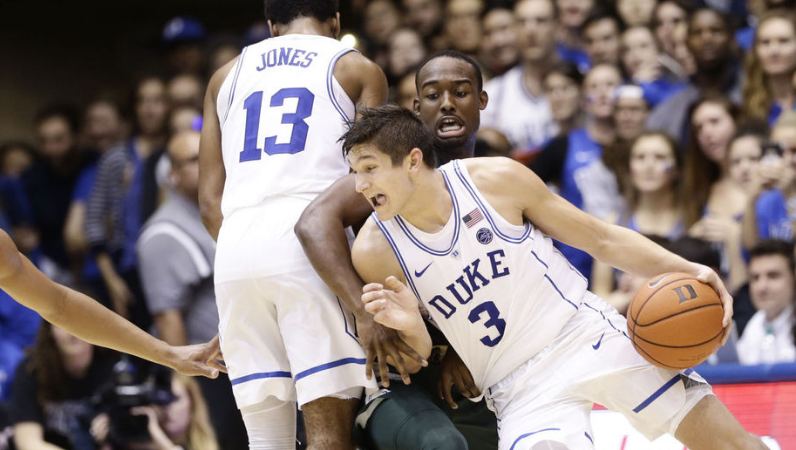Grayson Allen is at a very interesting crossroads in his basketball career. He has options — ones that would make him the envy of most aspiring NBA players.
There are but so many players like LeBron James or Chris Paul or Russell Westbrook in the world. Most professional basketball players cannot do everything on the floor. Most hoopers have defined roles — roles that ask them to bring something specific to the rotation without too much sacrifice of something else.
It may get lost under a mountain of trip-gate hot takes, but Allen is an extremely talented basketball player. He is skilled in discrete ways that are quite valuable at the next level. Defense will invariably be an issue, but Allen has the makings of an NBA player.
Let it fly
Allen’s shooting numbers regressed during his injury-plagued junior season, but he was still pretty darn good. According to Synergy Sports, he made 34.6 percent of his catch-and-shoots in 2016-17. That is down from his sophomore season, when he connected on 44.3 percent of his catch-and-shoot opportunities.
Overall, though, Allen was still an efficient shooter. Per Synergy, of ACC players to attempt at least 60 jump shots in 2016-17, Allen ranked 25th in points per possession (1.06) and 42nd in field-goal percentage (36.7 percent).
We have a lot of data over the course of three seasons that proves that Allen is a great shooter. In 105 career games, he shot 38.6 percent on three-pointers and nearly 49 percent from inside the arc.
His career true shooting rate hovers right at 60 percent, which is outstanding and very close to that of J.J. Redick. Klay Thompson, one of the best shooters to ever roam this planet, posted a true shooting rate of 55 percent while at Washington State.
Jumping Jack
Allen lost some of his explosion this season; that caused his numbers at the hoop to decline. However, according to Synergy, he still shot 55 percent on non-post-up attempts at the basket and drew a ton of fouls. The junior from Florida still drew 5.2 fouls per 40 minutes, according to KenPom.
On isolation plays, Allen drew a foul on over 28 percent on his 70 possessions. Plus, when Allen felt good, he was capable of doing things like this.
That is especially impressive when you consider that he played on a bum ankle for the majority of the season. Add in the fact that Allen spent a lot of time the last two seasons running a pro-style motion offense and now we are talking about an appealing prospect.
Two-way contract possibility
A new inclusion in the recently ratified CBA for the NBA could present a serious opportunity Allen and some other players. For the first time ever, the NBA will allow teams two additional roster spots that can be dedicated to two-way contracts.
These are deals that will allow franchises to control the rights to specific players and increase overall roster size to 17 players — 13 of which can dress for each game. Players on two-way contracts can float back and forth between the parent club and D-League affiliate. Their pay will adjust accordingly, too. When those players are in the NBA, they will make the standard minimum salary. When they spend time in the D-League, they will make between $50,000-75,000, which is tens of thousands of dollars more than the average salary.
The belief is that these types of contracts will be used more for developmental players — younger athletes who carry a great deal of potential but must refine their overall game, like Arizona’s Kobi Simmons.
Allen does not necessarily fit this mold, though, right? We know already what he does well. But this might be a solid landing spot for Allen if he fell to the second round (a likely scenario). It would give him a platform to prove that he is fit and capable of playing in the best league in the world.
There are reasons why Allen was viewed as a top-25 prospect before last year’s draft; he has game. However, he needs to get healthy, and time away from the spotlight at Duke would probably help, too.
Risk-Reward
There is a flip side to this, too. If a player is on a two-way deal, his rights are controlled by just one team. Essentially, his performance in the D-League would not be an open audition where the other 29 teams could look to sign him to their parent club. It is a risk-reward game when you are not a first-round pick. However, these two-way contracts could provide Allen another path to launch his professional career, which is something to consider.
Alternatively, Allen could return to Duke and be the senior leader for a young but talented bunch in 2017-18.

















